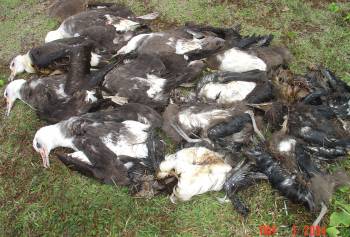The majority of the World's albatrosses breeds on uninhabited islands that are mostly free from land-based predators. However, on the main Hawaiian Islands in the North Pacific there are several small colonies of Laysan Albatrosses Phoebastria immutabilis which have taken up residence quite literally in people's backyards. In the neighbourhood of Princeville, Kauai, there are over 30 nests next to driveways, in front gardens and sometimes even on front decks; and on several large estates on Kauai's north shore more than 30 pairs breed on a single property. Thankfully most private landowners on Kauai have been very proactive in protecting their albatrosses through fencing, or in the case of Princeville, revised pet ordinances. Unfortunately though, the mix of pets, humans and albatrosses is not always peaceful.
On 22 June 2012, the day after all the chicks on the island were banded, several dogs ran through two of the larger privately-owned albatross colonies and killed eight chicks and injured five more mere days before they were ready to fledge, thereby virtually eliminating the chicks of this year's cohort from the affected sites. The dogs are also suspected of killing three Wedge-tailed Shearwaters Puffinus pacificus that were breeding nearby. The small, fenced colony that is located on the same parcel of land on the next bluff was unharmed - likely as a result of it being fenced.
The dogs were probably domestic pets that had been allowed to run loose - although this remains unproven without an eye-witness account. They may have run up from a public-access beach.
After their discovery, volunteers collected the five injured birds, four of which are currently being rehabilitated and prepared for release. Meanwhile, one of the property managers has offered to pay for traps to catch the dogs and to provide fencing and material to secure the property against future dog attacks. Whereas this attack is upsetting and demonstrates the need for fencing of these colonies, the good news is that it is becoming much less common now as a result of increased awareness and cooperation from private landowners. Let's hope the downward trend continues.

The accompanying photograph taken by Brenda Zaun, US Fish & Wildlife Service depicts the results of an earlier dog attack on adult and chick Laysan Albatrosses on Kauai in May 2004. At least 13 dead birds can be counted. Click here for a 2007 incident of dogs killing Laysans on Kauai.
Kauai and it its indigenous wildlife are also facing a new potential threat, from the alien Indian Mongoose, with two being recently trapped on the island, hitherto believed to be mongoose-free (click here). Mongooses are known to be capable of taking albatross eggs as observed at the Kaena Point Natural Area Reserve on another Hawaiian island, Oahu, before a predator-proof fence was erected to protect the colony.
Click here to read more about Kauai's suburban albatrosses. You can also view photos and video clips of suburban Laysans on Kauai at http://albatrossdiary.com/.
Lindsay Young, ACAP North Pacific News Correspondent, 5 July 2012

 English
English  Français
Français  Español
Español